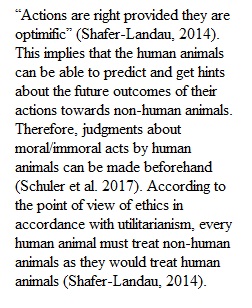


Q 4th Book Assignment Read: Shafer-Landau Chapter 9 – Consequentialism: Its Nature and Attractions Chapter 10- Consequentialism: Its Difficulties View Powerpoint in Bb - Utilitarianism Book Assignment Ideas pick one or multiple or answer one or multiple discussion questions at the end of each chapter, you can discuss one discussion question in all three paragraphs or you can answer more than one discussion question: • What implications does utilitarianism have for our treatment of non-human animals? How do utilitarian’s argue for their conclusions about non-human animals? Do you find the utilitarian’s conclusions about animals plausible? If so, why? If not, how would you respond to their arguments? • Write on developing what you take to be the most powerful objection to utilitarianism. Explain the objection in detail, and then describe how you think a utilitarian would reply. Is the utilitarian reply satisfactory? Defend your answer Minimum 400 words- Drop in Weekly Assignment DropBox (Maximum 30% originality) (See Guidelines)
Q What implications does utilitarianism have for our treatment of non-human animals? How do utilitarian’s argue for their conclusions about non-human animals? Do you find the utilitarian’s conclusions about animals plausible? If so, why? If not, how would you respond to their arguments?
View Related Questions